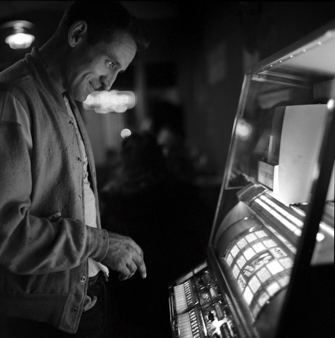
Seeing the Beat Generation enshrined in a museum like the Centre Pompidou can give pause to one old enough to have started reading books by Jack Kerouac, Allen Ginsberg, Gregory Corso, William Burroughs and such fellow travelers as Lawrence Ferlinghetti and Michael McClure around 1970. Kerouac and Neal Cassady (the inspiration for Kerouac’s On the Road) had recently died, the former of drink and fame (which didn’t agree with him), the second of burnout. The others were in their prime, with much of their best work still to come. Entering the hallowed halls of museums seemed unlikely, though Ginsberg, at least, was working on it.
This delightful multimedia exhibition includes film, television, photographs (including some by Burroughs and Ginsberg, as well as by such
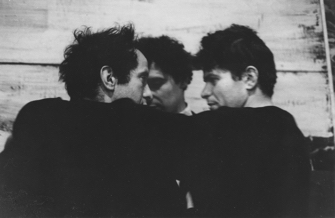
giants as Fred W. McDarrah, Robert Frank and Ettore Sottsass), paintings, collages and the dream machine that Brion Gysin invented at the Beat Hotel (9, rue Gît-le-Coeur in Paris). “We all thought we were interplanetary agents involved in a deadly struggle,” Burroughs wrote of the Beat Hotel days in his last great book, The Western Lands (1988).
The exhibition is fortunate to have Jean-Jacques Lebel among its co-curators – the others are Phillipe-Alain Michaud, Rani Singh and Enrico Camporesi. Lebel, a distinguished artist, has been a leading figure and avatar of Paris’s counterculture since the late 1950s, and he came to know most of the leading Beats at that time, when they were still little-known in France. Among the exhibition’s highlights are excerpts from Lebel’s 1990 interview with Ginsberg, which took place in the Beat Hotel, by then considerably spruced-up.
In the strict sense, the title “Beat Generation” is an anomaly. The Beats were less a generation than a small circle of friends centered around Columbia University in the late 1940s who then spread out to Greenwich Village, Denver, California’s Bay Area, Mexico, Tangiers and, during the late ’50s and ’60s, Paris, where Ginsberg worked on poems, Corso wrote “Bomb” and “Marriage,” and Burroughs got
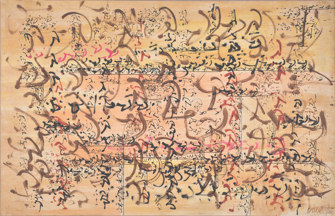
the idea (from his great friend Brion Gysin) for the cut-ups of his Nova Trilogy of novels.
The exhibition also spotlights West Coast figures like Ferlinghetti, a leading poet in his own right and publisher, through his City Lights publishing house, of all the Beats, especially Ginsberg, McClure and Gary Snyder, stars of the San Francisco Renaissance.
A highlight of the show is the legendary taped-together scroll on which Kerouac typed On the
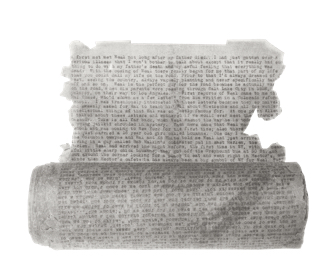
Road in 1951. Once he hit on this technique, he was able to work at feverish speed after months of gestation and false starts.
Kerouac, born to Breton-Canadian parents, sang the yea-saying American spirit, as had Walt Whitman and Kerouac’s idol, Thomas Wolfe, before him. On the Road speaks less of mid-century bohemian circles than of (to quote Ferlinghetti’s “The Canticle of Jack Kerouac”) “A Nineteen Thirties America/a Nineteen Forties America/an America now long gone/ except in broken down dusty old/Greyhound Bus stations/in small lost towns…/seen from a moving car window.”
Cassady (later the legendary driver of Ken Kesey’s bus, Further, which linked the two coasts in 1964) is seen at a jukebox in Los Gatos, California, in 1962, in a photo by Italian designer Ettore Sottsass, and with his then-companion (he had many, sometimes at the same time) Natalie Jackson in front of a 1956 triple-bill movie poster that includes The Wild One, starring Marlon Brando, in a photo taken by Ginsberg.
Ginsberg’s lens also captured Burroughs in front of a Mayan Codex (one of Burroughs’s obsessions) in March 1953 at New York’s Museum of Natural History, and Burroughs and Kerouac “in mortal combat” (Ginsberg’s description) with a Moroccan dagger and a broomstick.
Burroughs (a gun-lover who accidentally shot his wife to death in 1951 – something that tormented him for the rest of his life) spent much of the 1950s in Tangiers, where he wrote Naked Lunch. Paul Bowles, the author of The Sheltering Sky (among many other novels and stories) was one of Burroughs’s friends in Tangiers. The exhibition includes the 1959 album, “Music of Morroco,” compiled by Bowles, who was also a trained musician and composer.
The tape recorders and mimeograph machines that came on the market after World War II were much used by the Beats and are featured in the exhibition (they are sure to arouse feelings of nostalgia in those who were around at the time). Here, too, is the seminal six-record album of Harry Smith’s Anthology of American Folk Music (1952), vital to the Folk Revival of the late 1950s and early ’60s. Smith, an eccentric genius, gets his due here. He was close to Ginsberg, who helped him (and many others). Smith was also a friend to the Fugs, whose first album (such as it was) he produced. Tuli Kupferberg, a Fug, anarchist, poet, wit and erudite (born in 1923, he used to describe himself as the world’s oldest rock star) is seen here in a Robert Frank photograph selling his poems (50 cents each) outside a bookstore. New York hasn’t been the same since Tuli died in 2010.
A great revelation to many will be the paintings and drawings by many of the Beats. Little has been said about Kerouac’s pictures in the many
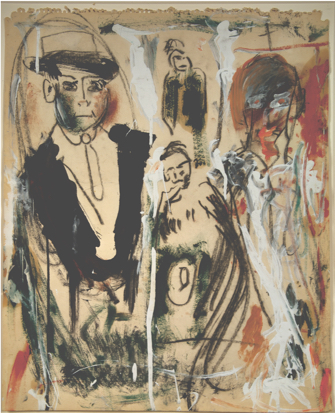
biographies written about him. Of those shown here, a favorite is the beautiful “Woman (Joan Rawshanks),” the title taken from his novel Visions of Cody, based on Joan Crawford. Several paintings by Julian Beck, the co-founder of the Living Theatre, are also on show.
While Pompidou is exhibiting Burroughs’s photographs, the Semiose Gallery, a few minutes’ walk away, is featuring his paintings. Burroughs is as yet little known as a painter, but the gallery’s selection is enough to convince one that his artwork will soon be as closely studied as his writing. Burroughs concentrated on painting in the last decade before his death, aged 83, in 1997. It complements his writing, minus the emphasis on sex and hard drugs.
There are only a couple of days left before the gallery show closes. Neither it nor the Beat exhibition are to be missed.
Semiose: 54, rue Chapon, 75003 Paris. Tel.: 09 79 26 16 38. Through July 23, 2016. www.semiose.fr
Favorite
